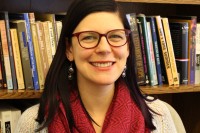Barney Zeitz, stained-glass artist, helps German church honor sanctuary's Jewish history

Barney Zeitz, 65, an artist on Martha’s Vineyard, Massachusetts, doesn’t know where in Europe his ancestors lived. But it could have been a town like Flieden, Germany, where there was a Jewish community from 1562 until 1938.
On November 9, 1938, the Flieden synagogue’s windows were broken during Kristallnacht, when Nazis vandalized synagogues and Jewish-owned businesses throughout Germany. The Nazis also burned the Flieden congregation’s Torah scrolls and other sacred objects, according to a website recording the history of synagogues in Germany. But the building survived, and a Protestant parish purchased it in the early 1950s.
A few years ago that parish, the Evangelische Pfarramt Flieden, received a visit from Marie Ariel, a Jewish woman who came to see the sanctuary where her father celebrated his bar mitzvah in 1899. The church wanted to honor the sanctuary’s Jewish history through stained-glass windows made by a Jewish artist. Ariel recommended Zeitz, whose work has included church windows as well as a sculpture for a Holocaust memorial museum in Rhode Island.
Read our latest issue or browse back issues.
Zeitz visited Flieden and met Thomas Fendert, the only person in the church who spoke English, who has since become “like a brother” to Zeitz. Fendert took Zeitz to the local Jewish cemetery, where all of the last names on the tombstones were familiar to him. He learned about some of the German people’s suffering after the war and how they’re responding to Syrian refugees today.
Then Zeitz spoke to a group of about 75 at the church.
“I told them about my great grandfather, and how I didn’t know which country he was from,” he said. He described his trip to the cemetery. “It was very emotional,” for him as well as for the congregation.
Fendert visited Martha’s Vineyard in September, and the Flieden church is beginning to explore a relationship with the congregation at the Martha’s Vineyard Hebrew Center.
Holger Biehn, pastor of the Flieden parish, wrote by e-mail that he is grateful to God for creating these connections “from our small village over the ocean.”
The first Protestant people came to Flieden as refugees after World War II, he wrote. They bought the former synagogue from a Jewish organization and renovated it. Nothing remained of the former synagogue interior.
“Former generations were very radical in eliminating every part of the synagogue,” Biehn wrote. “So we try to create a new thing.”
The congregation’s hope is to remember not only the destruction and sorrow of Kristallnacht and World War II, but to celebrate the whole Jewish history in Flieden, through the windows as well as through lectures and events at the church. They also are publishing a book, released in November. “Former generations tried to ignore the things that happened,” Biehn wrote. “Now we look for a honest interaction with the history.”
Biehn sees God’s hand in the congregation meeting Marie Ariel, who brought pictures of the sanctuary as a synagogue, sparking further interest. That led to connecting with Jewish families in the U.S. and Norway. And he trusts that “God will have some further amazing ideas,” he wrote. “Our project will be a little part of the big reconciliation between all people.”
Zeitz, while working on the stained glass for the church, is raising money to create a second set of windows for the Hebrew Center using the same frames. They now have a nonprofit sponsor so that donations are tax-deductible as they seek to raise another $100,000 for the Flieden project and $100,000 for the second set of windows in the Martha’s Vineyard synagogue (details are available at www.facebook.com/barneyzeitzfineart/).
Zeitz designed the windows with a landscape on which Numbers 6:24–26 is written in Hebrew and German.
“It’s this shared prayer for peace—Aaron’s prayer, the priestly prayer—that Christians and Jews have been using for thousands of years,” he said. “It all ends in the word peace” in windows on either side of the altar.
“When you walk into this church you’ll have this vision of these prayers running toward the front,” he said.
Zeitz begins with panes of single-color glass. He breaks them multiple times, recalling Kristallnacht, the night of broken glass, he said. But then he fuses them together, creating beauty out of the shards.
“There’s this broken, re-fused, broken, re-fused quality to it—I’d call it magical,” he said.
The windows will also include the star of David. He sees displaying that Jewish symbol as a “major step” for a Protestant church.
Zeitz is aware of five or six German churches meeting in sanctuaries that were once synagogues. To his knowledge, the Flieden parish is the first to do more than mount a plaque noting that history.
“It’s not about forgiveness, it’s not about an apology,” he said. “It’s not a Holocaust memorial.”
The windows instead commemorate the Jewish people who lived in the town for centuries.
“We were there,” Zeitz said. “This is a very generous, sincere acknowledgment—it makes me feel like I can go over there and say, ‘This is where my people are from.’”
A version of this article, which has updated information in the online version, appears in the November 23 print edition.







